Pros
Cons
Introduction
Front
{{section_header}}{{section.name}}{{/section_header}}
The Vizio XVT424SV is an average-to-ugly looking TV set with an angular bezel and glossy finish. It's not terrible, but the standard Vizio design could absolutely use an overhaul.

Back
{{section_header}}{{section.name}}{{/section_header}}
The back of the Vizio XVT424SV is a standard matte black plastic affair with all of the ports for the set and mount couplings.

Sides
{{section_header}}{{section.name}}{{/section_header}}
The television set itself is fairly thin, but could be thinner, as it is an edge-lit LED LCD TV. On the left side of the Vizio XVT424SV are the side input panel and the jag wheel, while the right side has nothing at all on it.

Stand/Mount
{{section_header}}{{section.name}}{{/section_header}}
The stand of the Vizio XVT3D424SV is a fairly average-looking high-gloss plastic piece that screws directly into the casing of the TV set. Unfortunately, the stand does not swivel, which makes access to the rear ports (which some are near-impossible to reach anyway) a real pain.

Controls
{{section_header}}{{section.name}}{{/section_header}}
All manual controls have been replaced by a single "jag wheel" on the side of the television set that controls only the power and the volume by tactile manipulation, and the other main controls via a menu that's toggled by tapping the wheel. While it's interesting to see a different way of doing things, the jag wheel certainly makes a lot of manual control options a bit more complicated, and is less intuitive or useful than Vizio thinks. Bring back the buttons!
Just like on a text-oriented cell phone, the remote has a slide-out QWERTY keyboard, and in addition to the normal functions and connectivity to the set, it has a bluetooth connection for operations that are too data-rich for the weaker IR signal.

Remote Control
{{section_header}}{{section.name}}{{/section_header}}
Even though it looks like it came out of an 80's music video, the remote control for the Vizio XVT3D424SV is wonderful, and it allows you to do more than remotes of other internet-capable TV sets.

In the Box
{{section_header}}{{section.name}}{{/section_header}}
The Vizio XVT3D424SV comes packaged with a manual, remote, batteries, stand, cleaning cloth and power cable.
Black Level
{{section_header}}{{section.name}}{{/section_header}}
The Vizio XVT3D424SV's black level was measured at an appallingly bad level of 0.42cd/m 2. This is one of the worst levels we have recorded for an LCD TV, and consequently it affects other areas of scoring too, notably contrast. If you would like to lower this, you may try to lower the backlight setting, but be advised that you can only do so by either altering the presets, or using the custom picture mode.
In all fairness to the Vizio XVT3D424SV, we tested the black level with all additional video processing turned off, so items like Smart Dimming and the Ambient Light Sensor were disabled for the duration of our tests. We do this because these features, while they significantly improve the readings we take, usually detract from overall viewing experience if they change mid-picture, which can be distracting. These features tend to give Vizio TVs much-improved readings when they are turned on, but because we always turn additional video processing off for every TV we test, it would be unethical to give Vizio special treatment. More on how we test black level.
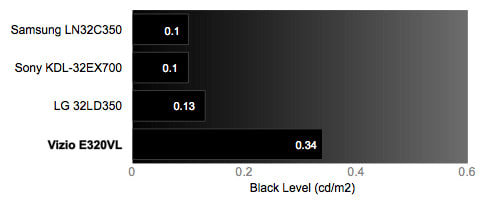
Peak Brightness
{{section_header}}{{section.name}}{{/section_header}}
In contrast to the poor black-level, the Vizio XVT3D424SV had an extremely good peak brightness of 417.71 cd/m 2. Granted, we expect high peak brightnesses from LCD TVs, which tend to have no issues in this area. Still, this is an area in which plasma screens typically struggle, as you can see in the comparison chart below. More on how we test peak brightness.
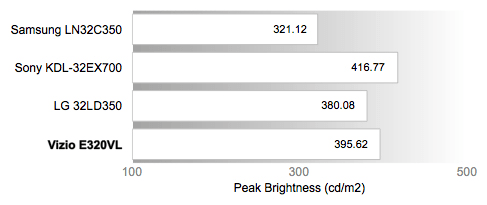
Contrast
{{section_header}}{{section.name}}{{/section_header}}
Due to its abysmal black level, the contrast ratio for the Vizio XVT3D424SV was also quite poor. Clocking in at 994:1, the Vizio XVT3D424SV barely edges out the LG 47L6500, but still falls short of providing an average contrast ratio. For the sake of honesty, this ratio would be improved greatly if you turn on the additional video processing options, but expect the issues discussed above. More on how we test contrast.

Tunnel Contrast
{{section_header}}{{section.name}}{{/section_header}}
The Vizio XVT3D424SV had only minor troubles maintaining a consistent black level, no matter how much or how little black was on the screen. Again, these readings were taken with the Smart Dimming feature off. With that feature turned on, this score would horrendously bad due to the nature of Smart Dimming. More on how we test tunnel contrast.
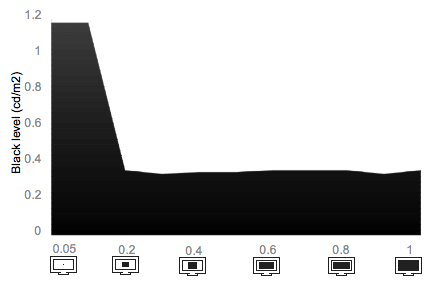
White Falloff
{{section_header}}{{section.name}}{{/section_header}}
The Vizio XVT3D424SV had no trouble maintaining a consistently bright white either, keeping a similar brightness regardless of how much or how little white there was on the screen. Again, Smart Dimming would have wrecked any good performance in this area. More on how we test white falloff.
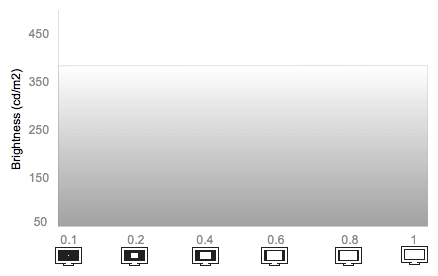
Uniformity
Greyscale Gamma
{{section_header}}{{section.name}}{{/section_header}}
The greyscale gamma test gives us a complete picture of how well a TV transitions from black to white in the greyscale. The Vizio XVT3D424SV had some minor difficulties in this transition, as you can see on the chart below there was a small range of shades that weren't displayed correctly (the dip near the beginning of the line).
Another important feature to note is the slope of the line in the greyscale gamma chart. While the slope of the line is outside of the ideal range (2.1 to 2.2), it isn't that bad compared to other TV sets we've tested in the past. Overall this score is decent, so good on you Vizio! More on how we test greyscale gamma.
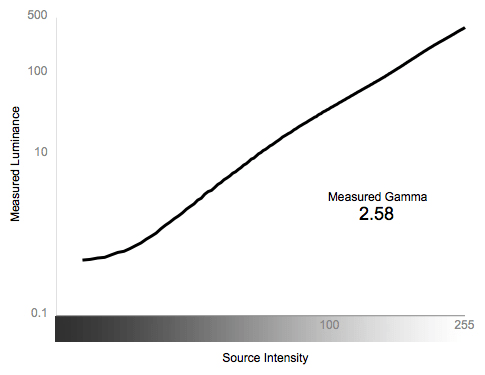
Color Temperature
{{section_header}}{{section.name}}{{/section_header}}
As you can see in the chart below, the Vizio XVT3D424SV displayed extremely little color temperature error, even if it did consistently warm whites over the entire range of signal intensity. Because the error percentage is so low, you will probably not even see it even if you are looking for it. More on how we test color temperature.

RGB Curves
{{section_header}}{{section.name}}{{/section_header}}
The Vizio XVT3D424SV had very minor issues in the RGB color tests. As you can see below, the only issues that we found reared their heads towards the absolute brightest end of the signal intensity. Even then, there were very few jagged lines, meaning that there are very few colors that the Vizio XVT3D424SV can't produce. It seems that the the reds will have a little more trouble than the blues and the greens in terms of color banding, but aside from that the RGB curves are beautifully smooth. More on how we test RGB curves.

Below are linear representations of each RGB curve as compared to corresponding data from each of the comparison models.
Motion Performance
{{section_header}}{{section.name}}{{/section_header}}
Overall, the Vizio XVT3D424SV handled motion acceptably, but it still could have functioned better for how much this TV set is priced. Though the motion smoothness was about what you'd expect from an entry-level TV, the TV had noticeable problems with artifacting and a sluggish refresh rate. The TV lost the normal amount of detail in moving pictures to motion blur, which was corrected mostly with the Smooth Motion Effect setting.
Where the Vizio XVT3D424SV disappoints is with motion artifacting. Not only does it tend to display jagged edges on items that are moving, but it also skews them to one side, turning squares into parallelograms etc. While this is fairly common in entry-level TV sets, we had hoped to see better from a TV in its price range.
In addition to these issues, we feel it necessary to add a small caveat about the Smooth Motion Effect. While most new TV sets have a similar feature, you should know ahead of time that this makes any film-based content look bizarre. While it may boost motion scores in tests by eliminating motion blur, in your normal viewing you may decide that this additional video processing is not for you. More on how we test motion performance.
3:2 Pulldown & 24fps
{{section_header}}{{section.name}}{{/section_header}}
The Vizio XVT3D424SV did not do too badly in terms of 3:2 pulldown testing. With a high-frequency pattern, it struggled to display an even picture without additional processing, but when the Film Mode setting was set to Auto, it showed no trouble at all. That being said, its performance was subpar when displaying a slowly-moving picture, as the Film Mode did not seem to register the video as motion, as it made no difference whatsoever in that one environment. More on how we test 3:2 pulldown and 24fps.
Resolution Scaling
{{section_header}}{{section.name}}{{/section_header}}
The Vizio XVT3D424SV has a native 1080p resolution, but a lot of the things that you watch will probably be of a lower resolution. Consequently, when an image's size is changed to fit the screen, the TV's internal processor has to rescale the image. The following is how the Vizio XVT3D424SV performs with alternate resolutions in content. More on how we test resolution scaling.
480p
The Vizio XVT3D424SV lost 3% of the top and bottom and 2% of the left and right sides of the screen to overscan.
720p
With the 720p content, the Vizio XVT3D424SV lost no image area to overscan, but showed a little difficulty with false coloration in high-frequency patterns.
1080i
With 1080i content, the Vizio XVT3D424SV lost nothing to overscan, but had some issues with false coloration in high-frequency patterns.
3D Effect & Experience
{{section_header}}{{section.name}}{{/section_header}}
So far, it's been our experience that plasma TVs handle 3D content, and the Vizio XVT3D424SV does nothing to contradict this observation. Although it performed better with some operations than others, bad crosstalk, active shutter glasses and poor handling of depth really make the Vizio XVT3D424SV's 3D experience barely even watchable. This seems like one of the areas that plasma screens will almost always be better equipped to handle than LCD screens, so this result is not surprising. Still, we need to emphasize how bad the picture becomes once you flip on the 3D; at best it has artifacts and really bad juddery motion, at worst it may give you headaches or nausea. We'll continue on to back this up with cold, hard data below.
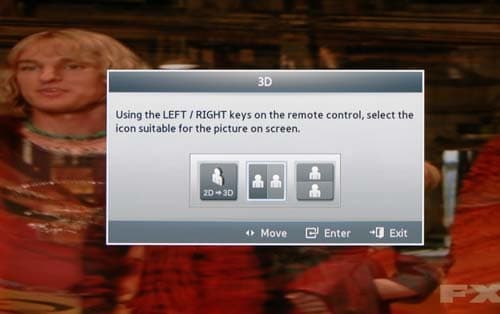
Some of the options in the 3D menu
3D Black & White
{{section_header}}{{section.name}}{{/section_header}}
As per usual with active-shutter glasses, black levels, peak brightness and contrast all dropped with the switch from viewing 2D to 3D content. However, in easily the most surprising result of the day, the 3D content actually had excellent greyscale gamma (not pictured here), sporting a slope right in the ideal range of 2.1 to 2.2. Still, having great performance in greyscale gamma when the screen is hard to see makes it almost a moot point, but we like to be fair to our TVs.
The chart below outlines the change in black and white performance when you switch from 2D to 3D.

3D Color
{{section_header}}{{section.name}}{{/section_header}}
The Vizio XVT3D424SV handled color temperature error in 3D fairly well, netting a score of 9.79 in our standard color temperature error tests. This seems to be a fair bit better than some of the other 3D TVs we've tested recently.
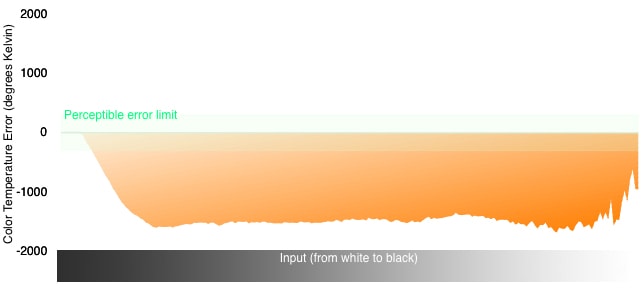
The Vizio XVT3D424SV had great difficulty with the RGB curves. Due to the locked calibration, for better or worse Vizio doomed the XVT3D424SV to have subpar color performance in 3D. Note the jaggedness of the lines and the early peaks of the blue and green lines
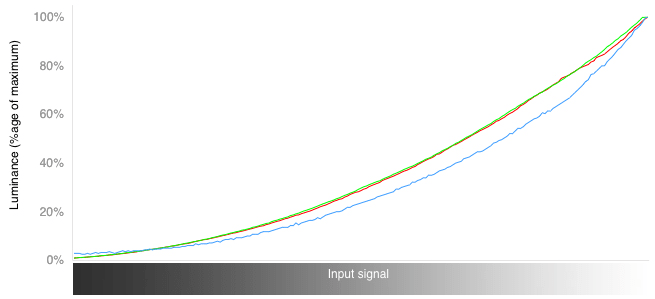
The color gamut of the Vizio XVT3D424SV does its best to remain close to the rec. 709 standard, but undersaturates its blues and oversaturates its greens. We realize that it's tough to maintain color data when you're actively blocking much of the light coming through the glasses, but it hasn't stopped other TVs like the Panasonic comparison model from maintaining a better level of color accuracy.
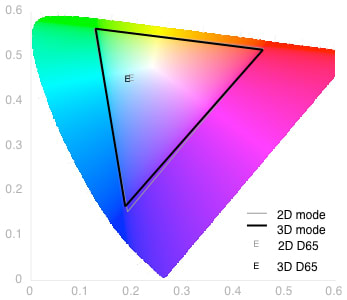
3D Crosstalk
{{section_header}}{{section.name}}{{/section_header}}
In layman's terms, 3D crosstalk is what happens when an image intended for one eye bleeds into the other eye's field of vision. You may notice some "ghosts" of objects while watching 3D content, and it can be very distracting and annoying.
The Vizio XVT3D424SV has a horrible problem with crosstalk. Even without scoring for this area, I can tell you that you'll notice lots and lots of crosstalk on any 3D content you watch. When we set the Vizio XVT3D424SV up in the testing lab and viewed our test footage, we noticed that crosstalk was a huge problem with objects in the foreground and most of the background. Again, in comparison to a plasma TV, the LCD TV will almost always perform worse in this regard, so if 3D content is important to you, you may want to explore plasma-screened options. That said, if you want a pristine picture and flawless 3D performance, we wish you luck in finding it because we haven't so far.
3D Glasses
{{section_header}}{{section.name}}{{/section_header}}
The Vizio XVT424SV's 3D glasses do not come with the TV set itself, forcing you to buy extra accessories when you pick up your television set. While this in and of itself isn't surprising, prepare to balk at the sticker price when you try to pick them up, as they run over $200. Obviously, active shutter 3D glasses are expectedly more expensive than passive shutter glasses (what you get at the movie theater), but this is still fairly ridiculous pricing.
The glasses themselves are basic in design, and offer no customizability whatsoever. If they don't fit you at first, you're out of luck. The nose brigde and ear loops aren't too uncomfortable, but be aware they may build up some moisture in a hot or unventilated room. Even though they have decent battery life (if what the insert said is true), you will still have to charge the glasses, which can be yet another hassle that passive shutter 3D does not have to worry about.
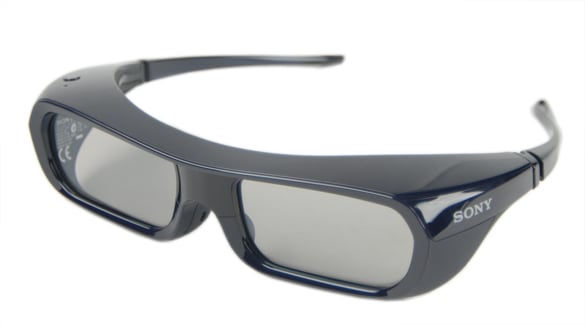
Yes, you will look like a dork with these on
Formats
{{section_header}}{{section.name}}{{/section_header}}
The Vizio XVT3D424SV has a standard resolution of 1080p and can display all standard NTSC resolutions.
Viewing Angle
{{section_header}}{{section.name}}{{/section_header}}
The Vizio XVT3D424SV had a viewing angle of 51 degrees total, which is on the higher end of average for an LCD TV. It's important to note that LCD TVs usually have bad viewing angles by the very nature of their design, although newer screens with different technology can correct some of these issues while creating other problems of their own. In context, this score is not as bad as it may seem at first.

Reflectance
{{section_header}}{{section.name}}{{/section_header}}
The Vizio XVT3D424SV's screen was very reflective, despite its attempts to reduce glare. While watching normal cable TV, if there is a bright light in the room or if the sun happens to shine near the screen, you will notice a large sunburst pattern, along with a very wide and diffuse glow over much of the screen.Needless to say, this is quite annoying, and can seriously disrupt any viewing experience.
Video Processing
{{section_header}}{{section.name}}{{/section_header}}
The Vizio XVT3D424SV has a decent array of additional video processing features, discussed in the table below.
Calibration
{{section_header}}{{section.name}}{{/section_header}}
Like many of the 2010/2011 Vizio TV sets before it, the calibration on the Vizio XVT424SV was frustrating. In order to make the necessary changes to calibration settings, we used Movie mode as a starting point, and then switched the mode to Vivid to make our changes. As you'll see in the chart below, there were several additional video processing features that we turned off. It is important to note that we were unable to optimize color temperature because of locked settings and somewhat unhelpful presets.

All of our calibration is done in conjunction with the DisplayMate software.
](http://www.displaymate.com/)
Video Modes
{{section_header}}{{section.name}}{{/section_header}}
The Vizio XVT3D424SV has a bunch of video processing modes for different viewing situations, some more useful than others.
Connectivity
{{section_header}}{{section.name}}{{/section_header}}
The Vizio XVT424SV has a decent amount of ports on the back of the TV's casing, including 4 HDMI input ports, 1 composite, 1 component, and a LAN port (with the option of WiFi connectivity AFTER you conduct a firmware update). If you have a bunch of digital external media sources, you'll most likely be satisfied with the connectivity options on the Vizio XVT424SV.

On the back of the TV set, you'll notice that there is an additional downward-facing panel with most of the HDMI input ports, cable input, and PC in ports.
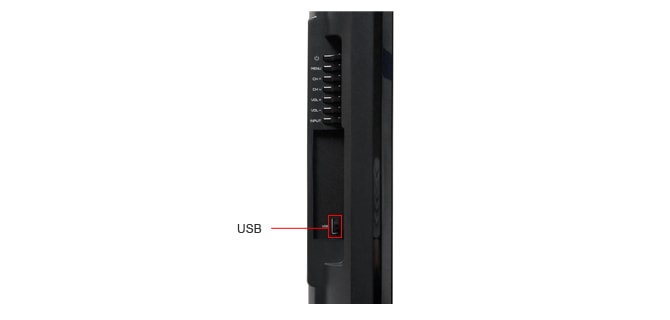
On the side of the TV set, there is a small panel that allows you to connect USB devices easily into any of the three ports provided, as well as an additional HDMI input.
{{product.manufacturer_specs['Connectivity Tour Image 3']}}
Placement
{{section_header}}{{section.name}}{{/section_header}}
It seems Vizio is still trying to figure out how best to position some of the ports on the back to accommodate the wall mount. While most ports are easy to reach, the rear HDMI ports are a major inconvenience to reach. We understand that the downward-facing ports are meant to accommodate users who want to hang their TV set on the wall, but there has to be a better way to do this; the ports are almost impossible to access without great effort once the stand or mount is installed. While the Vizio XVT424SV has easy-to-reach ports on the side of the set, but chances are, you won't be using USB ports and 1 HDMI input all the time, so the issues with the placement in the back are likely to give you a headache.
Audio Quality
{{section_header}}{{section.name}}{{/section_header}}
Nobody in their right mind would ever mistake the sound system of the Vizio XVT3D424SV for a true 5.1-channel surround sound system, but for a TV with two 15-watt speakers, it does okay. For all of you who prefer to use an external sound system, you'll be delighted to know that this TV has settings that either allow you to control the levels from your external receiver, or even kill the TV's speakers while you use your own sound system.
In addition to the standard audio presets, there are additional audio processing features. Though you'll probably keep this option off, SRS TruVolume normalizes volume output between fluctuating volume levels. the SRS TruSurround enhances audio quality, but doesn't really function as advertised: two speakers can't really replace a surround sound system, no matter how they're branded.
Output options are quite good for audio in this TV as it sports analog and digital audio out, which isn't something we always see in this price range but is a welcome surprise.
Menu Interface
{{section_header}}{{section.name}}{{/section_header}}
The main menu is a bit different than 2010 Vizios in that you can access all of your internet applications from it, rather than having to open a submenu to get them. All of the TV's settings and preferences are located in the HDTV settings submenu, highlighted below.

Much like the menus of the other 2010/2011 Vizios, the menus of the Vizio XVT424SV are frustrating, to say the least. Even if this TV has less hangups in terms of locked features, the complete inability to change the backlight setting outside of changing picture presets makes our calibration of the television set very difficult. The advanced picture menu also has come settings that you will want to turn off during calibration, but here too, there are settings that are impossible to change no matter what you do. So far we've managed to unlock most of the settings, but we've yet to figure out how to turn off the "real cinema mode."
Eventually, we unlocked the backlight setting after updating the firmware and messing around with the presets. After all that hassle, we felt like there should be some acknowledgment of our Herculean efforts.


Instruction Manual
{{section_header}}{{section.name}}{{/section_header}}
Vizio XVT424SV has a somewhat-informative manual, even if it lacks specifics about many of the more advanced features of the TV that have not been added due to a lag in firmware development. The index and table of contents could be a bit more clear, but the pictures and charts are illuminating, so you shouldn't have much trouble setting up your TV set if you read the manual. You can find the Vizio XVT3D424SV's manual online here.

A manual for so many TV models, they have to be further categorized by type.
Internet Features
{{section_header}}{{section.name}}{{/section_header}}
The Vizio XVT424SV has a bunch of pre-loaded streaming content applications that allow you to browse a decent range of services. Because many of the news and information applications are Yahoo! widgets that are found on many internet-capable televisions, you will be able to download new applications as long as Yahoo! and Vizio remain partnered. A more complete list of offerings can be found on this huge comparison chart.
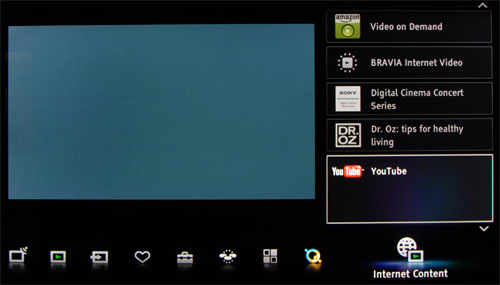
Local Media Playback
{{section_header}}{{section.name}}{{/section_header}}
It seems that local media playback for this TV set is not currently available, but the instruction manual and Vizio website claim that picture, audio and music playback will be available via the USB ports and internet applications after a future firmware update. It is recommended that you update your television set before attempting to connect any other USB device to the back so that you can have these options when the firmware becomes available.

Other Media
{{section_header}}{{section.name}}{{/section_header}}
The Vizio XVT3D424SV does not support any other type of media.
Power Consumption
{{section_header}}{{section.name}}{{/section_header}}
All things considered, the power consumption of the Vizio XVT3D424SV is fairly low for an LCD TV. As you will see below, this is the advantage an LCD TV offers over plasma screens, as the latter draw much more power to operate. According to our projections, it will probably cost you around $14.78 to run the Vizio XVT3D424SV per year depending on your backlight level setting, as explored in the table below.
The Vizio XVT3D424SV draws less power than the other comparison models, including the plasma screen of the Panasonic TC-P50ST30, which draws a comparatively enormous amount of power. As you can see below, all three LCD TVs have a much lower cost to operate than the plasma screen, which is something you'll find is a fairly universal tradeoff between the two types of screen.
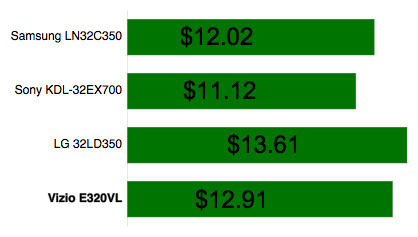
Value Comparison
{{section_header}}{{section.name}}{{/section_header}}
The Panasonic TC-P50ST30 is a 50-inch plasma screen 3D TV that offers better performance at a slightly higher price. Because the Panasonic and the Vizio XVT3D424SV have different types of displays, certain areas will be better than others. For example, plasma screens almost universally have much better viewing angles, but also draw much more power than LCD screens. So far, we've found that plasma screens also handle 3D content much better, so a value comparison depends greatly upon what you would like your TV set to do. Keep in mind that the Panasonic will draw almost 3 times the amount of power that the Vizio XVT3D424SV does.
Blacks & Whites
{{section_header}}{{section.name}}{{/section_header}}
While the Panasonic TC-P50ST30 has a much lower black level than the Vizio XVT3D424SV, it struggles to create a bright screen. While anything above 200 cd/m2^ is bright enough to view content in a brightly-lit room, the Panasonic TC-P50ST30 struggles to achieve only half of this level.

Color Accuracy
{{section_header}}{{section.name}}{{/section_header}}
In terms of color temperature error, the Vizio XVT3D424SV displayed a less measurable error over the entire range of signal intensity than the Panasonic TC-P50ST30. Still, on both sets you are unlikely to see the slight warming of the colors at any point as the phenomenon is mostly below the level of human perceptibility. Both sets had close RGB performance, but again, the Vizio XVT3D424SV holds the edge in this category, as shown in the color strips below.
Motion
{{section_header}}{{section.name}}{{/section_header}}
The Vizio XVT3D424SV outshines the Panasonic TC-P50ST30 in motion performance, more than doubling its score in motion artifacting. Though the Vizio XVT3D424SV is not great in terms of motion artifacting, it's still leagues better than the Panasonic TC-P50ST30 in this category.
Viewing Effects
{{section_header}}{{section.name}}{{/section_header}}
As can be expected of any plasma screen, the Panasonic TC-P50ST30 has a much better viewing angle than the Vizio XVT3D424SV. This is just one of those things that set plasma screens and LCD screens apart from each other, and it is highly unlikely that you will find an LCD screen on the market with a comparable viewing angle to a plasma screen.
Connectivity
{{section_header}}{{section.name}}{{/section_header}}
The Vizio XVT3D424SV offers a few more connectivity options than the Panasonic TC-P50ST30, with an extra HDMI input, bluetooth connectivity and analog audio out.
Other Comparisons
{{section_header}}{{section.name}}{{/section_header}}
As mentioned in the 3D section, the Panasonic TC-P50ST30 is a plasma screen, and based on what we've seen so far, will naturally have a better 3D picture than the Vizio XVT3D424SV. While the Vizio XVT3D424SV has significant problems with crosstalk, reduced color gamut and juddering, the Panasonic TC-P50ST30 provides a much smoother picture with less color error and issues with motion. There really is no comparison between the two in terms of 3D performance: the Panasonic TC-P50ST30 is the superior TV in that regard in almost every metric.
Value Comparison
{{section_header}}{{section.name}}{{/section_header}}
The Samsung UN46C7100 has a much higher MSRP than the Vizio XVT3D424SV, but offers much better picture performance. Still, the anemic viewing angle and the comparatively minor differences between the two sets make it hard to justify spending up to $1300 more for the Samsung UN46C7100. If you do decide that you like the Samsung UN46C7100, we suggest looking online for a lower price before heading paying full MSRP.
Blacks & Whites
{{section_header}}{{section.name}}{{/section_header}}
Much like the Panasonic TC-P50ST30 comparison model TV, the Samsung UN46C7100 blew the Vizio XVT3D424SV away in terms of black and white performance. Not only does it have a darker deepest black, but it also has a much better contrast ratio.

Color Accuracy
{{section_header}}{{section.name}}{{/section_header}}
Both the Samsung UN46C7100 and the Vizio XVT3D424SV performed very well in minimizing color temperature error along the entire range of signal intensity. Though the Samsung scores better, you will not notice a difference in color temperature error between the two. In terms of RGB performance, the Vizio XVT3D424SV scored higher than the Samsung UN46C7100, but the difference is again very small, as you can see in the RGB strips below.
Motion
{{section_header}}{{section.name}}{{/section_header}}
The Samsung UN46C7100 outperformed the Vizio XVT3D424SV in terms of motion performance, not only does it display a smoother picture, but it also has less troubles with artifacting.
Viewing Effects
{{section_header}}{{section.name}}{{/section_header}}
A shockingly bad shortcoming of the Samsung UN46C7100 is the viewing angle, which is only 10 degrees from center on either side of the screen. Here, the Vizio XVT3D424SV has the clear advantage, as its viewing angle is two and a half times wider, as you can see on the chart below.
Connectivity
{{section_header}}{{section.name}}{{/section_header}}
The Vizio XVT3D424SV and the Samsung UN46C7100 have relatively similar connectivity options, but the Vizio XVT3D424SV has one more HDMI input, bluetooth connectivity and an analog audio out that the Samsung does not have.
Other Comparisons
{{section_header}}{{section.name}}{{/section_header}}
Like the Vizio XVT3D424SV, the Samsung UN46C7100 is an LCD, and as such struggles a bit with 3D performance. Motion tends to be jittery (like it would appear with a low frame rate) and there are significant crosstalk issues, which both sets seem to have problems with. Because we don't score, it's a bit hard to compare the two in this area, but by virtue of the fact that the Vizio XVT3D424SV is newer, there may be firmware updates or expanded features more palatable to the buyer, but we warn you that 3D on LCD TVs is fairly universally terrible.
Value Comparison
{{section_header}}{{section.name}}{{/section_header}}
While the LG 47LX6500 has a much higher MSRP, at this point in its life cycle, you should be able to find it for a lower price online. In terms of performance, both the LG 47LX6500 and the Vizio XVT3D424SV are fairly similar, although the Vizio has a much more reflective screen than the LG. Be aware, though, that the LG 47LX6500 offers a selection of input and output ports that dwarf that of the Vizio XVT3D424SV.
Blacks & Whites
{{section_header}}{{section.name}}{{/section_header}}
The Vizio XVT3D424SV outperformed the LG 47LX6500 in everything but deepest black level, but did not perform drastically better. For most viewers, the difference won't be very noticeable, minus the fact that the Vizio XVT3D424SV's screen is brighter.

Color Accuracy
{{section_header}}{{section.name}}{{/section_header}}
Both the Vizio XVT3D424SV and the LG 47LX6500 performed very well in our color temperature error tests, neither one displaying much of a perceptible error in color temperature along the entire range of signal intensity. In terms of RGB performance, both sets are again very close in their scoring, with the LG taking a small lead on the Vizio XVT3D424SV by a fraction of a point.
Motion
{{section_header}}{{section.name}}{{/section_header}}
The LG 47LX6500 fared marginally better than the Vizio XVT3D424SV in our motion testing, scoring only one quarter of a point higher than the Vizio. Overall, they have roughly the same performance in this category.
Viewing Effects
{{section_header}}{{section.name}}{{/section_header}}
The LG 47LX6500 has a slightly larger viewing angle than the Vizio XVT3D424SV, as you can see on the chart below. What sets the two TVs apart is screen reflectivity; the LG 47LX6500 does a much better job diffusing a reflection than the Vizio XVT3D424SV, and will deal with bright lights shining directly onto the screen much better.
Connectivity
{{section_header}}{{section.name}}{{/section_header}}
The LG 47LX6500 has a much larger array of analog options, which is nice to see as most 2011 TV sets are starting to do away with these ports in favor or HDMI input. As you can see below, the connectivity options on the Vizio XVT3D424SV simply do not come close to the LG's offerings.
Other Comparisons
{{section_header}}{{section.name}}{{/section_header}}
In terms of 3D content, both sets are LCD TVs, so naturally their 3D experience is going to be terrible. No matter how you slice it, both have significant problems with crosstalk and motion juddering despite the enormous cost of having the 3D option for your TV. In our minds, it's not really worth it just yet to buy a TV solely based on 3D capability.
Conclusion
Overall, the Vizio XVT3D424SV isn't a horrible TV set, but it definitely struggles with basic picture performance, atrocious menus and poor 3D performance.
If you're looking for a TV that is going to impress, the Vizio XVT3D424SV is not it. Again, it isn't bad per se, but we expect a bit more of a TV for a price tag that high. In our minds, having the 3D option isn't worth the extra money or hassle. After all, an average TV with 3D is still just an average TV set: certainly not anything to write home about.
Model Series Comparison
{{section_header}}{{section.name}}{{/section_header}}
The XVT3Dxx4SV series has just two models other than the Vizio XVT3D424SV, a 47 inch and a 55 inch. All three are 3D TVs, but none come with the 3D glasses needed to view 3D content.
Photo Gallery
{{photo_gallery "Front Tour Image", "Back Tour Image", "Sides Tour Image", "Stand Photo", "Controls Photo", "Remote Control Photo", "Connectivity Tour Image 1", "Connectivity Tour Image 2", "Connectivity Extra Photo", "Menu Main Photo", "Menu 2 Photo", "Internet Features 1 Photo", "Internet Features 2 Photo", "Internet Features 3 Photo", "Local Media Playback 1 Photo", "Local Media Playback 2 Photo"}}
Ratings & Specs
{{manufacturer_specs_table}}
Meet the tester
A seasoned writer and professional photographer, Chris reviews cameras, headphones, smartphones, laptops, and lenses. Educated in Political Science and Linguistics, Chris can often be found building a robot army, snowboarding, or getting ink.
Checking our work.
Our team is here to help you buy the best stuff and love what you own. Our writers, editors, and experts obsess over the products we cover to make sure you're confident and satisfied. Have a different opinion about something we recommend? Email us and we'll compare notes.
Shoot us an email